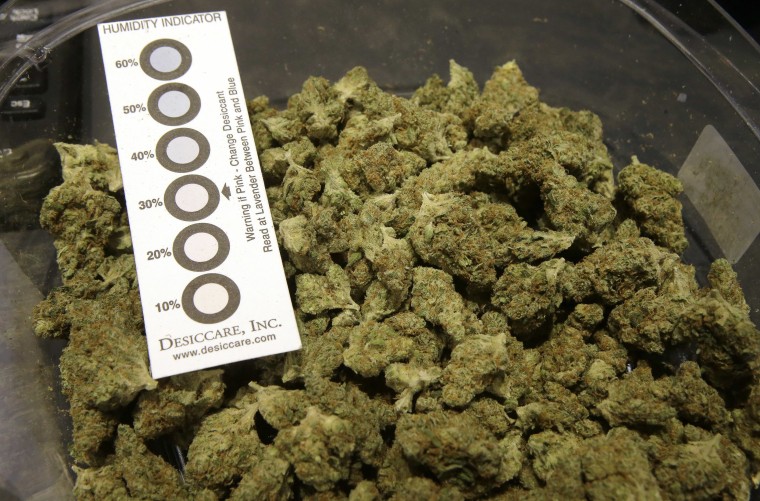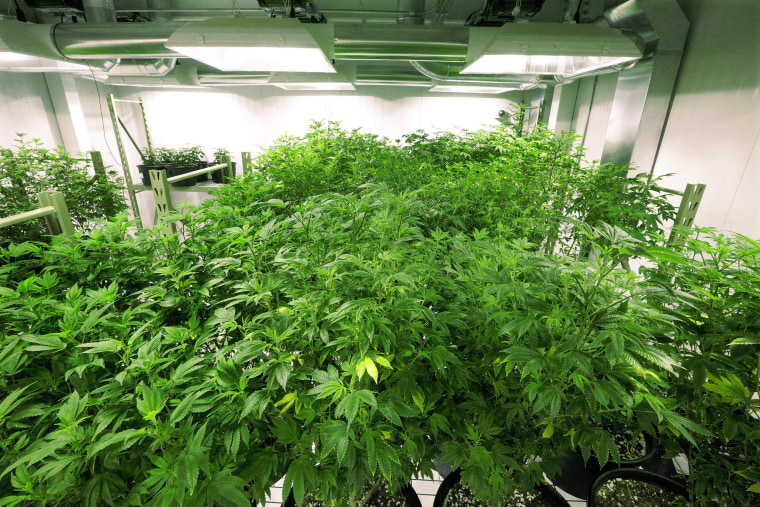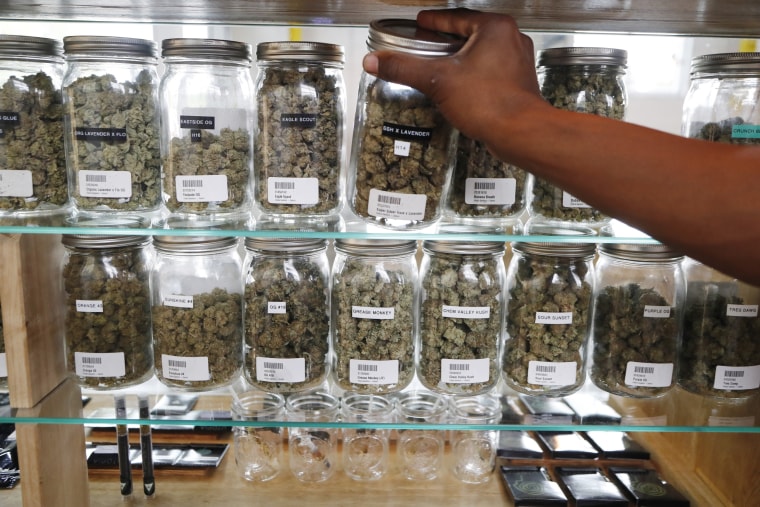WEST HOLLYWOOD, Calif. — Holiday shopping was in full swing Friday at a boutique on Santa Monica Boulevard, where an automatic sliding door welcomed browsers off the street.
Inside the well-lit shop decorated with Christmas wreaths, glass cabinets filled with elixirs, herbal pills and pen-size vaporizers beckoned. The dark wood floors and brand-name displays could have come out of a Sephora cosmetics store. Shoppers have to look past gleaming jars and fancy boxes to find what brought them here — old school marijuana "flower," the part of the plant that people smoke to get high.
The hot products at Alternative Herbal Health Services are tinctures, pills and liquids that contain cannabinoids, such as THC and CBD, that are extracted from cannabis plants. The results include products with a consistent, reliable experience.
Simply smoking the cannabis flower doesn't provide that level of dependability time and again, but marijuana retailers and their customers would like it to. Yet that product — considered by some to be legal pot's holy grail — still largely eludes the multi-million dollar industry at a time when it’s experiencing historic expansion.
“That’s been the goal forever,” said Greg Zuckert, vice president of cultivation for cannabis producer Harvest Health & Recreation.
A number of companies, some publicly traded, are chasing the goal of growing a predictable plant by hiring decorated scientists, setting up labs and building research greenhouses previously used mainly by so-called Big Agriculture. They're hoping a product people can rely on will translate to millions of dollars in sales.
The latest market forecast from by Arcview Market Research in partnership with BDS Analytics concludes that U.S. "retail flower sales are forecast to grow at a compound annual growth rate of 14.8 percent to reach $8.5 billion in 2022."
Still, according to that forecast, a growing portion of pot store customers are opting for processed cannabis concentrates that give them a more consistent impact.
“Folks are using it in new forms, low-dose, edibles, tinctures, capsules, and what they care about is the effect,” said Jon Vaught, CEO of agricultural technology firm Front Range Biosciences. “But there are consumers who want to consume cannabis the way they have for years. They like the things they know.”
Front Range and a handful of other companies are hoping to patent unique marijuana plants — some cannabis patents have already been granted — that could produce consistent crops with repeatable effects for users.

In November, Michigan became the 10th state to legalize recreational marijuana. Thirty-three states and the District of Columbia have approved some form of legalization, broadening the market for what has been until now a product mastered outside the lab.
Mowgli Holmes, chief scientific officer of Phylos Bioscience in Portland, Oregon, is heading a team that’s hoping to sequence the DNA of all known cannabis strains.
“We’re using genetic information to help people do plant breeding and develop new varieties,” he said.
The goal is not only to reproduce a high, but to be able to control that high, Holmes said.
“No one ever knows what they’re getting, and it’s a huge problem,” said the scientist, who has a doctorate in microbiology from Columbia University. “It’s making it so the industry doesn’t work very well. Often it’s way too strong. It’s Russian roulette. New customers get burned and don’t come back.”
Holmes believes his work can also lead to high-yield marijuana that’s easy to grow and resistant to mold and mildew.
“Plants will have really defined characteristics for consumers and growers,” he said.
Smokers of traditional cannabis are used to strain names like O.G. Kush, Girl Scout Cookies and Blue Dream. But scientists say those names are meaningless. Even the two major species of marijuana, indica and sativa, offer no real predictable properties, experts say.
“There’s not any true indica or true sativa anymore,” Zuckert said. “Everything is a hybrid. Forty years of breeding without any provenance being recorded and that’s the reality.”
Strain names like Sour Diesel and species specifications like indica or sativa can inspire consumers to picture a flavor or outcome, but that’s often all in their head, said Tim Gordon, chief science officer of hemp oil producer Functional Remedies.
“It’s marketing rather than consistency,” he said.
Zuckert said he’s using “software, tissue culture and genetic management” to churn out plants with consistent effects.
“If you don’t bring in successful commercial agriculture practices, you’ll lose your edge,” he said.
Creating the perfect pot plant, or at least one as consistent as year-round tomatoes, means identifying effective cultivars, or plant types, and reproducing their telltale effects by creating genetic recipes balanced by their fragrant terpenes (the plant's essential oils) and psychoative cannabinoids.
“I’m working on genetic markers and looking at taking DNA from different species, trying to create genetics to fit neurochemical profiles to treat different ailments,” Zukert said. “These are exciting things.”
The results could be patented plants used in specific products or sold as brand-name flowers for smokers. If that happens, strains like O.G. Kush favored by many pot aficionados might not have a place on dispensaries’ shelves for much longer.
“In the future, those strains will all be irrelevant,” said Marcus Walker, founder of Cult Classics Seeds in Colorado.

“It doesn’t matter what it's called once it’s correctly characterized and a good breeder can replicate it,” said attorney Gary Hiller of California’s Napro Research, a California seed-to-sale producer.
At Alternative Herbal Health Services in West Hollywood, owner Dina Browner, who has long said she was the inspiration for the Showtime series “Weeds,” acknowledges the retail scene has evolved rapidly, particularly after California voters passed recreational legalization for users 21 and older in 2016.
She says concentrated cannabis products, such as liquid-filled cartridges for vaporizers, are getting the industry closer to solving the problem of inconsistent effects.
“You might not have the same tomato, but with these concentrates, you can get the same tomato stew,” she said.
But Browner acknowledges that return customers often revert back to old-school marijuana flower, which can produce an inner haze that can’t be touched by processed cannabis products. AHHS is producing its own boxed brand of traditional marijuana.
“People still love flower,” she said.


